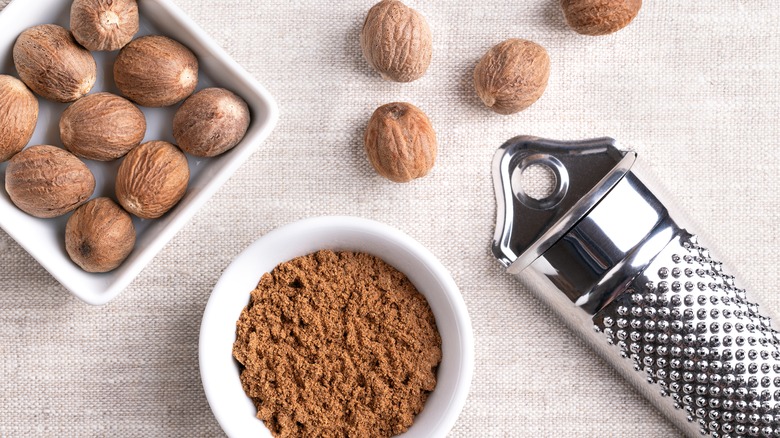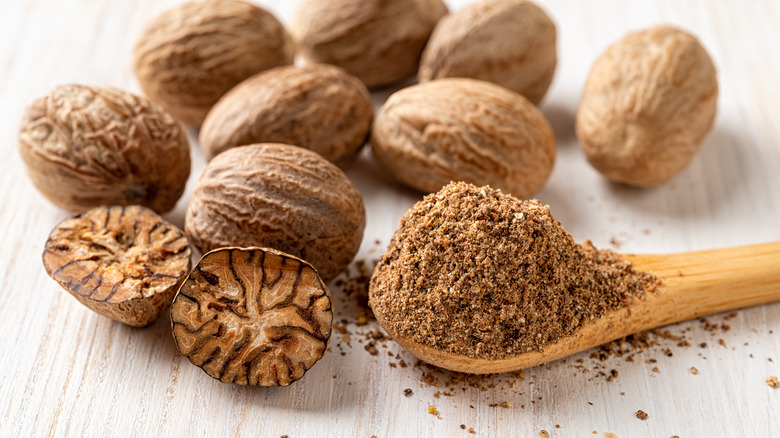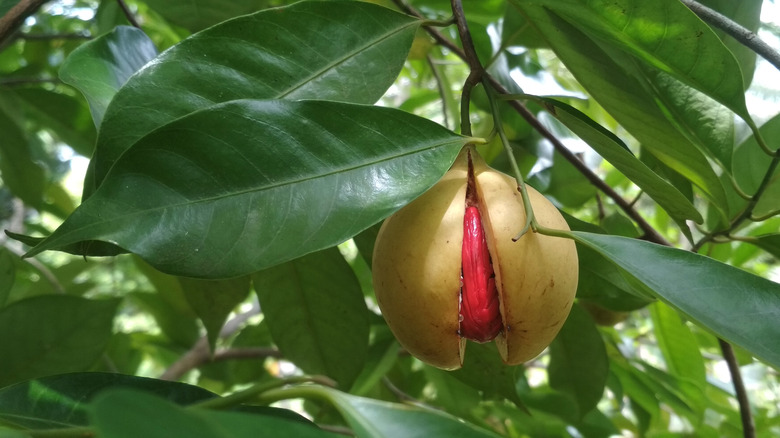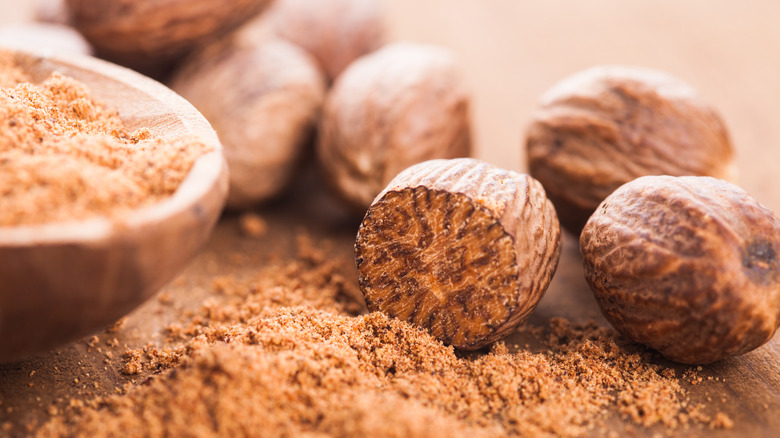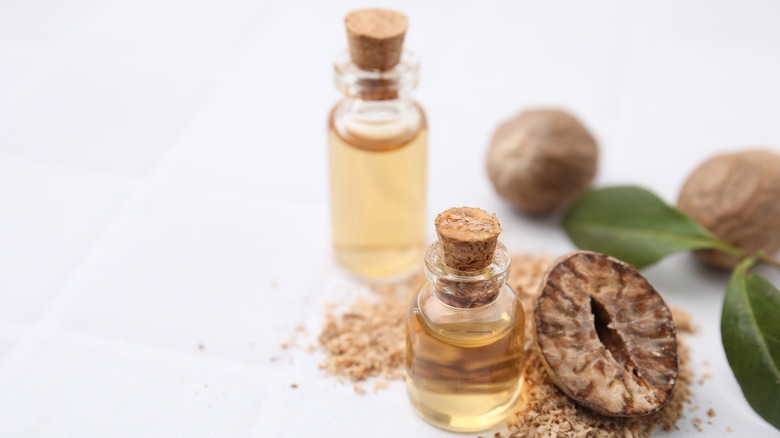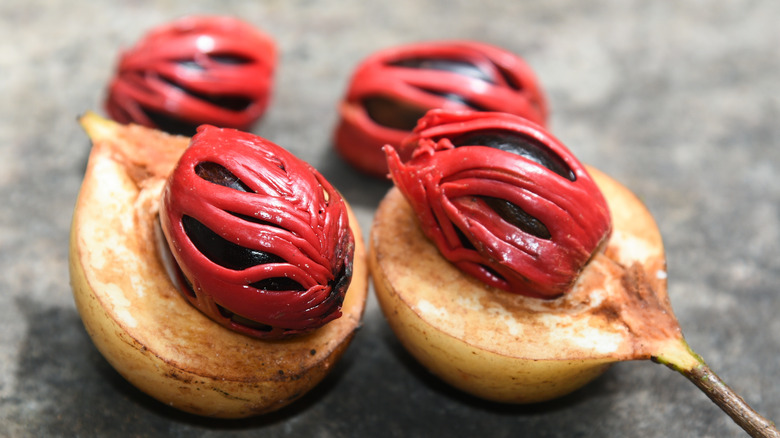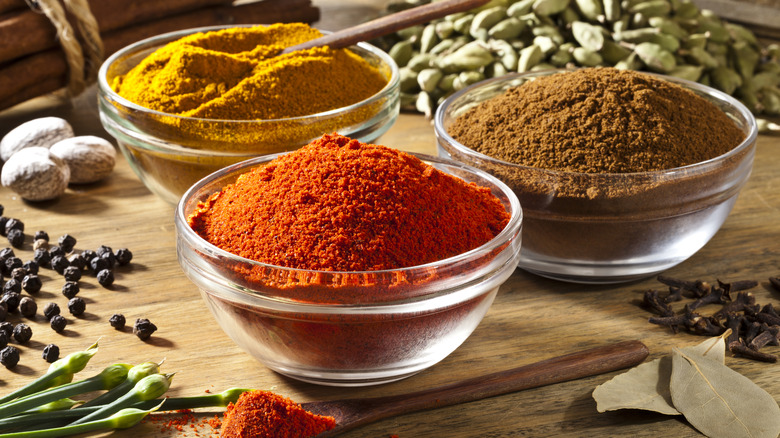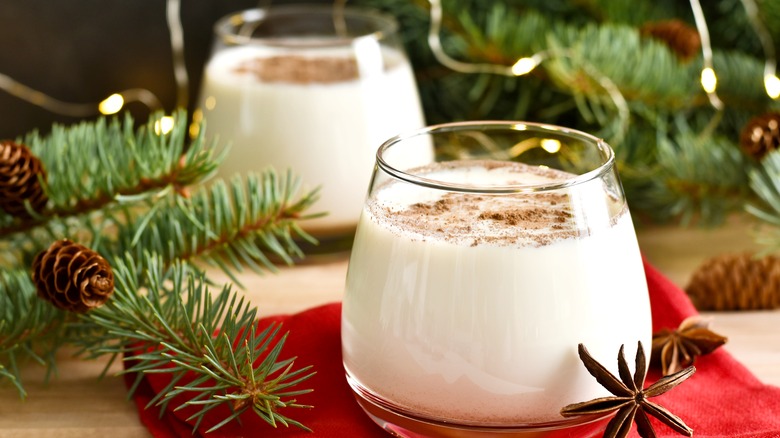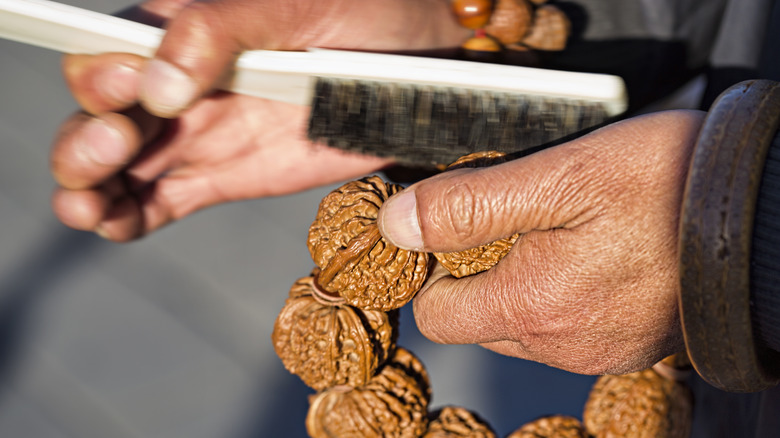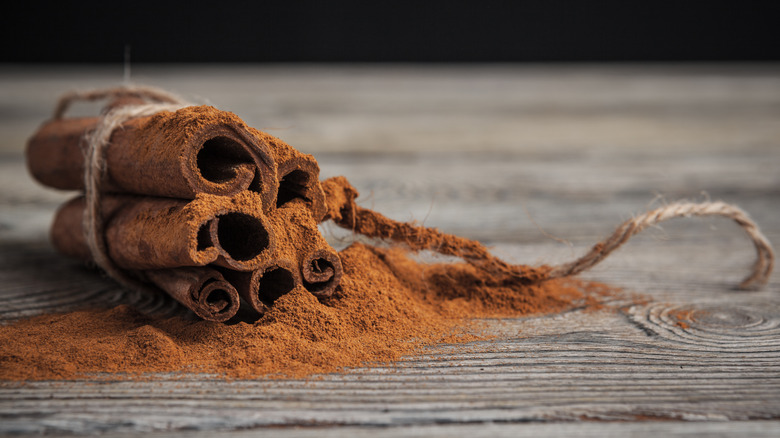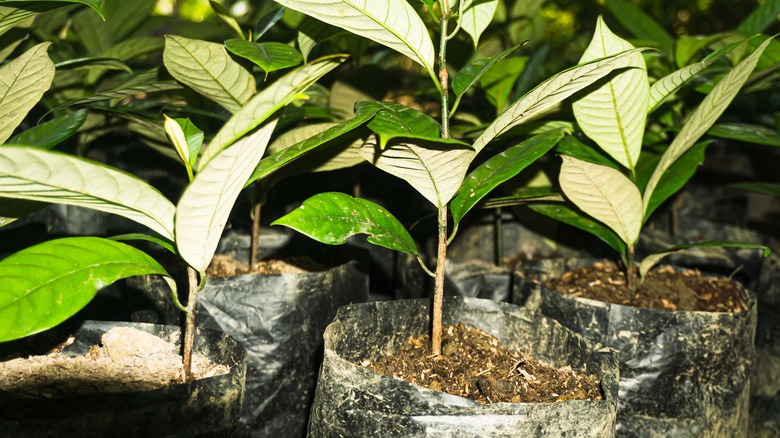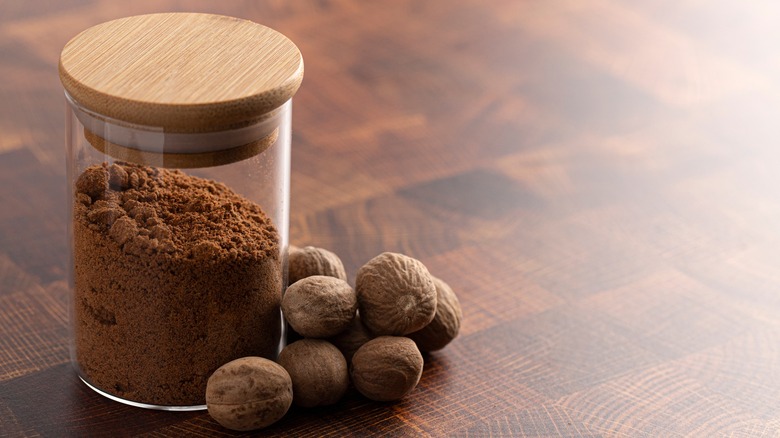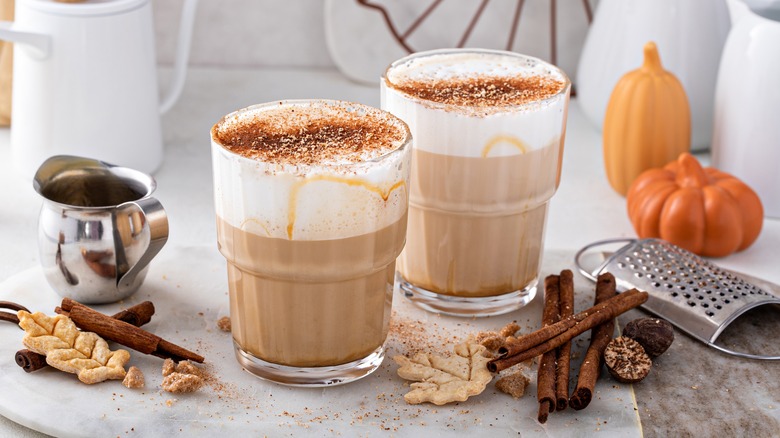The Definitive Guide To Nutmeg
If there's one thing we all know about nutmeg, it's that you can't make a good eggnog recipe without it. Also, it's in some cookies. And sometimes other drinks. Creamed onions, maybe? But many people are unaware of its many other uses, which is tragic, because nutmeg's truly inimitable flavor makes everything so much better.
Nutmeg has long been a staple of spice racks around the world. Used as everything from an air freshener on the streets of Imperial Rome to a food preservative in many cultures, nutmeg has seriously seen some things ... and it has the history to prove it.
Today, nutmeg should be playing a much bigger role in the average kitchen. Its warm, fragrant, earthy, spicy, and nutty tones lend both sweet and savory dishes a complexity you just can't get anywhere else. From mulled wine and pasta to curry and squash soup, we. need. more. nutmeg. Accordingly, here's a comprehensive look at nutmeg's provenance and uses, and best practices for putting it to work in your cooking.
What is nutmeg?
The name nutmeg refers both to the evergreen tropical tree (Myristica fragrans) from which this spice is gathered as well as the inner pit of the nutmeg tree's fruit, which is dried and sold whole or ground into a fine powder, among other preparations. Nutmeg is native to a tiny corner of the globe known as the Spice Islands, part of Indonesia, and it is not actually a nut. The word "nutmeg" is derived from the Latin words for nut ("nux") and musky ("muscat"). It's possible that the Arab word "mesk" may also have had something to do with its etymology.
Nutmeg trees can grow as tall as 65 feet, fruiting about 8 years after they are planted, with the greatest production beginning at age 25 and continuing for decades. It has bright to medium-green leaves and produces a smallish yellow fruit that looks a bit like a plum or apricot, that locals sometimes eat. When the fruit is fully ripe, it splits open to reveal the pit, which is comprised of an inner brown seed and a red, lacy-looking outer covering called an aril.
A brief history of nutmeg
Nutmeg has been around for a long time. While it didn't make its way into widespread use in the Mediterranean region until Arab traders brought it around the 6th century CE, it was likely known in Ancient Greece and Rome, though it probably was not widespread in food and drink at that time. That was all to change, because by the 12th century, the European upper crust was completely obsessed with the stuff. This wound up being good for the traders, who were now marking it up by 6,000%.
Tragically, this did not make for peaceable relations among the countries of Europe, all of whom wanted to control this rare (at that time) and valuable product. By the 1600s, nutmeg was in wide enough demand that it generated war between the English and Dutch. Indeed, the Dutch love of nutmeg is why the U.S. now holds Manhattan (then a boggy piece of undesirable land), which the British got in return for a nutmeg-producing island, Pulau Run.
In its history, nutmeg has been sold as a plague deterrent, aphrodisiac, and even hallucinogen (though it takes roughly 5 grams of the stuff to feel psychoactive effects). Holy Roman Emperor Henry VI had it spread throughout the streets of Rome for his 1191 coronation. Today, it is available all over the world ... mostly for more humble uses, such as eggnog and really great cookie plates.
Modern nutmeg cultivation and production
Today, as in ancient times, nutmeg is primarily grown for the fragrant seeds that, when grated, add a warm, sweet earthiness to dishes. While the Mystica fruit is edible, it is not grown for that use. The fruit is sometimes used as a byproduct, but its sour flesh means it does not taste good on its own. Instead of eating it raw like the apricot it resembles, people typically juice it and then add sugar. Think lemonade, but with a spicy, earthy twist.
Most nutmeg is grown in Indonesia and Grenada. It is, however, cultivated in a raft of other countries as well, including Sri Lanka, India, the Philippines, Zanzibar, Mauritius, Tobago, Trinidad, the Pacific Islands, the Caribbean, and other parts of the Americas. Nutmeg must be cured for weeks before it's ready for use. This involves waiting for the fruit to ripen and fall from the tree, then removing the seed, taking off the aril, and allowing it to dry in the sun before sale.
The flavor of nutmeg
There's a reason people fought literal wars over the control of this spice: its sweet, warm, delicate flavor, courtesy of chemical compounds such as sabinene, pinene, and limonene. Nutmeg is aromatic, woody, slightly bitter, and a bit nutty. Some sources describe it as having notes of clove, tobacco, and citrus as well. If you add it to baked goods or hot cereals, it will sweeten them all on its own, without the addition of extra calories. Indeed, in this writer's opinion, one of the biggest mistakes you can make with oatmeal is not putting nutmeg in it.
A word of caution, though: While it is delightful in small amounts, if you use too much nutmeg, it can become overpowering. Pay attention to the instructions in your recipe and don't veer too far off the path (this goes for any spice, by the way). If you think the recipe doesn't have enough nutmeg, add additional seasoning with a restrained hand.
Available forms of nutmeg
Nutmeg is available both ground in a bottle, and as seeds, also called nuts. These are always from the same species, no matter where they are grown in the world. However, their provenance does have an impact on their flavor. If you want a more highly aromatic nutmeg, choose the darker East Indian nutmeg, which has a higher percentage of the volatile oils that lend it its distinctive aroma. For a milder taste and a lighter color, choose West Indian nutmeg. You may have to do some research to discover its source, but if you really care, online spice companies will typically say.
Nutmeg is also available as an essential oil. While you can use essential oils in cooking, you must check the recipe, as oils and dried spices are not interchangeable. More commonly, essential oils are used for perfumes, aromatherapy concoctions, and candle making. Some herbalists also recommend it for homemade toothpaste, as a digestive, or as an aid to relaxation. Always ask your doctor about taking essential oils orally, as herbs and spices are contraindicated for certain types of medication.
Nutmeg versus mace: Two sides of the same coin
Nutmeg and mace are often seen as two different spices. It's an easy mistake to make, given that they're sold under different names and in different jars. However, they are actually two sides of the same coin — one and a half spices if you will. Nutmeg is the seed, while the red, lacy or feathery aril is what becomes mace.
Complicating matters further is the fact that you can't simply take off the aril and produce nutmeg. There is yet another covering of the nutmeg seed which must be removed before using. It is only the inner seed, once revealed and dried in the sun, that becomes what we know today as nutmeg. The aril, on the other hand, is removed and pressed flat to dry, then ground into mace.
So, is there any difference between nutmeg and mace? The answer is yes. Mace is said to be spicier and more pungent, closer to cinnamon and black pepper in flavor and strength. However, if you taste nutmeg and mace side by side, you will detect their similarities on the palette.
How to choose the best spices
There are a few tips for choosing the best spices. You can use color, best-by date, and form of nutmeg as a clue for finding the most flavorful spices. At the grocery store, look for vibrant colors that indicate the spice is still fresh and pungent; muted colors mean the spice is older and less flavorful. If possible, smell the spice. You can do this at bulk stations. Under no circumstances should you buy spices past their best-by date, by which time they will have lost at least some of their flavor.
If you want the absolute best spice experience, experts say you should avoid the store entirely. Instead, seek out a spice merchant or head to an ethnic market, where spices are often of higher quality for prices that are still affordable. If neither of these works on a local level, buy your spices online. Ideally, purchase whole spices and grind them yourself for the highest standards of freshness and flavor. The good news is, grinding nutmeg yourself is quite easy to do.
Whole vs. ground nutmeg
Now comes an important question: whole or ground nutmeg? If you want to take the easy route, you probably considered the whole nutmeg seed at the store, thought "nah," and bought the grated powder instead. No one can blame you, and that's what this writer did for years.
However, using whole nutmeg has some serious advantages, mainly in the flavor arena. Spices in the supermarket are already old and stale, perhaps a year old or more. The good news is, whole nutmeg seeds take a long time to lose their pungency, which is why they are often preferred in the kitchen by serious chefs.
Grinding your own spices might seem intimidating, but it's really not. Because nutmeg is large and relatively soft, it's easy to grate it using a zester or dedicated nutmeg grater. The ideal is to grate only as much as you need for that dish, to keep the rest of the nut fresh. If you want to grind a considerable quantity of your own nutmeg at once, you can also use a coffee grinder.
Common uses for nutmeg in the kitchen
Nutmeg is most commonly used in America for sweet treats, especially those we associate with the fall and winter months. Think breads, pies, and eggnog. It is critical to apple and pumpkin pies, and used in many a berry pie as well. Anything with "spice" in the name — think apple spice cake, spice bread, or spice cookies – contains nutmeg as often as not.
Despite the American association of nutmeg with desserts, it is also a common ingredient in savory cooking throughout the world ... and right here at home. Nutmeg is a classic addition to béchamel sauce or creamed onions, is included in many lasagna recipes, and is an ingredient often used in veggie dishes, stuffing, and rice.
You can even use nutmeg to pep up a light and fluffy carrot soufflé (that is, if you're feeling extremely brave and immune to disappointment, since soufflés are basically made to break hearts). And although it has a sweet flavor, nutmeg is great in a variety of meat dishes, good on everything from lamb to spice rubs for grilling.
Other uses for nutmeg
You can also use nutmeg to sweeten a variety of drinks, such as coffee, hot chocolate, and smoothies. In fact, did you know you can even add ground nutmeg to your French press to add a deliciously exotic flair to your morning cuppa? That's right, and that freedom extends to cinnamon, ginger, cardamom, or any other flavor you want to explore. (French presses are also a great way to make spiced drinks such as chai, BTW.)
If you're looking for a fun twist on cocktail hour, consider using nutmeg in your next drink. The aptly named Painkiller combines rum, pineapple juice, orange, cream of coconut, and a bit of nutmeg for a delightfully spiced twist on the piña colada. It's the perfect summer drink ... or perhaps more often if you live in a hot climate. For a concoction that will keep you warm on winter nights, try a spiced Manhattan, which employs a cinnamon stick stirrer and lots of spices, as well as a sprinkle of decorative nutmeg across the top.
You can also use it as a decorative addition to your bead box. All you have to do is take dried nutmeg seeds and drill holes through them, then string them on fishing line or stretchy thread. If you want, you can use a grater to etch patterns on the surface of the seeds. Next stop: dope necklaces!
Substitutes for nutmeg
Nutmeg has its own distinct flavor, but you can use many other warm spices in its place if you don't have it. If you are combining it with other spices, you may even get away with leaving it out of the recipe entirely. However, if nutmeg is the star of the show, you probably want to make an effort to procure some ... or at least use a substitute that mimics it fairly well.
The best substitutes for nutmeg are other spices that hail from tropical climes. These include cinnamon, allspice, cardamom, cloves, and ginger. Naturally, mace is also a good option, as it carries many of the same flavors that nutmeg does, albeit spicier. You can also use spice blends such as pumpkin pie spice, apple pie spice, or garam masala, an Indian spice blend.
Before you substitute, make sure to look up whether that particular spice or blend will work in that recipe. In some cases, it won't. For instance, while ginger is a great sub in a savory recipe, it may not do the trick in a dessert that calls for nutmeg's naturally sweet flavor.
Growing your own nutmeg
Want to grow your own nutmeg? You totally can, as long as you live in United States Department of Agriculture hardiness zones 10 and 11. This includes parts of California and the South, as well as Hawaii and Puerto Rico. If you don't live in those areas, nutmeg cultivation is beyond your reach. (In which case, if you want homegrown nutmeg, you better cultivate some very specifically located friends instead.)
If you do live in the appropriate zones, however, you can plant a nutmeg tree in your backyard. Note that if you do, however, you should choose a grafted specimen. These start producing fruit in 3 years as opposed to 8. Plus, only female trees produce, so getting a grafted tree will ensure you can actually harvest anything. Keep in mind that nutmeg trees need a lot of space to grow and time to reach maturity, so don't plant one at a rental.
Health benefits of nutmeg
Nutmeg offers any number of health benefits. It relieves pain, aids in digestion, fights free radicals, balances blood sugar, and helps your brain do Brain Things. Getting more nutmeg in your diet is definitely a good idea.
One of its biggest selling points is the ability to combat free radicals. These come at us from any number of sources, including chemicals, environmental toxins, and the air around us. Free radicals are also created as a result of exposure to solar radiation. No matter their source, free radicals can create oxidative stress, damage our cells, and cause cancer, so nutmeg's antioxidant properties are a major boon.
Nutmeg is also indicated for better sleep and an improved mood, which partially explains its hallowed role in folk medicine. Its antibacterial properties help explain its presence in dental products. To get these health benefits, all you have to do is use the spice more often. Add it to warm drinks, oatmeal, or fruit salad. Toss it on veggies. Bake with it. All of the above will increase the perks you see from ingesting nutmeg.
Storing nutmeg to last
Yes, there is a right way to store spices for best flavor. For one thing, you should always store them in an airtight jar, whether they are pre-ground or whole. This keeps moisture out, which can cause nutmeg to clump or break down. For another, you should keep them away from heat and light, as those degrade the flavor more quickly. If possible, put them in a dark cupboard so they will last longer.
While you can freeze spices and it won't do them particular harm, they are best kept at room temperature. While herbs and spices never truly expire because they are shelf stable, they do lose their flavor over time. The USDA recommends you keep them for 2-4 years in whole form and 2-3 years if ground. For that reason, it's best to purchase small amounts and replace them as necessary.
Nutmeg nutritional information
Nutmeg contains very few calories, only 12 per teaspoon. The same amount contains 3% daily value of polyunsaturated fat and 2% of daily fiber, as well as trace amounts of vitamins and minerals. These include vitamins A, C, and E, manganese, magnesium, copper, phosphorous, zinc, and iron. As such, spices (even in small amounts) are a great way to enhance your overall health and wellness.
Note that too much nutmeg can have a surprising effect on you, and it can even be dangerous. In amounts excess of 2 teaspoons, it can cause poisoning that may even lead to blackouts and hallucinations. Other symptoms include nausea, dizziness, dry mouth, and brain fog. It is possible to die of nutmeg poisoning, which is most common when people try to take it for fun. Small children who don't know better are also at risk, which is why you should always keep herbs and spices on a high shelf or in a cupboard/drawer that is inaccessible to them.
